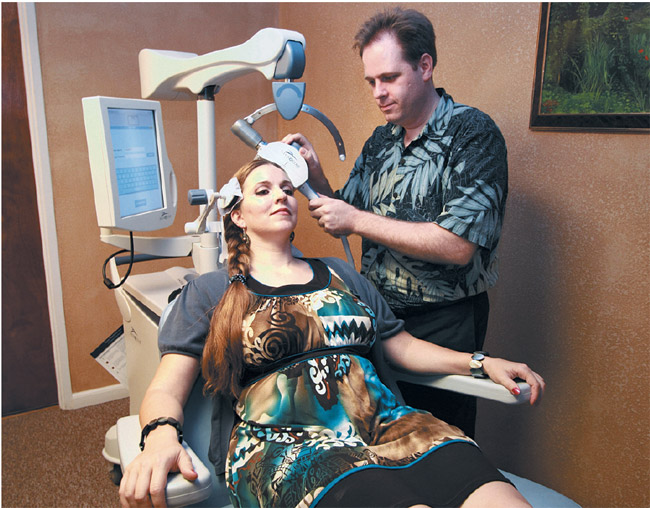New Treatment For Depression
Dr. Jeremy Roberts
Owner of Advanced Psychiatric Therapeutics
Where did you receive your schooling/training?
I received my medical degree at Medical College of Wisconsin and completed my psychiatry residency at Tufts Medical Center in Boston. I learned to perform Transcranial Magnetic Stimulation (TMS) procedures at McLean Hospital in Massachusetts.
dih_drjeremyroberts_2
How long have you been in practice?
Almost four years.
What is TMS?
Instead of medications that spread systemically through the body, TMS uses a strong (MRI-strength) magnetic field focused on a particular area of the brain that is known to be less active in depressed areas, effectively trying to stimulate the brain cells to fire more regularly. It is a new, effective, noninvasive and FDA-approved treatment for depression that has been thoroughly tested and proven safe and effective without the considerable side effects that can occur with the use of many medications or electroconvulsive therapy.
What conditions is TMS used for?
At this point in time, TMS is FDA-approved only for the treatment of depression. But there are several promising smaller studies for several other disorders such as tinnitus (constant ringing in the ears), chronic pain, fibromyalgia, PTSD and auditory hallucinations. Usually, our patients have tried several antidepressants but have not significantly improved, or had significant side effects while on them. TMS is non-systemic (doesn’t distribute through the body), so it also offers the ability to treat people who may not want to or can’t take medications, such as pregnant women or patients with multiple adverse reactions to prior medications.
What are the benefits of TMS over other forms of depression treatment?
For many people, there are medications that will help them through a bout of depression, but the majority of patients, according to many studies, do not resolve the episode with an initial trial of therapy or medication. Even with multiple medication trials, about a third of depression cases still don’t resolve. Other patients experience a loss of medication effectiveness over time, or the side effects of the medications become too severe. For these patients, the options become progressively limited as more treatments are found ineffective. TMS has been a very helpful new tool to treat these patients.
Is TMS used on its own or in conjunction with medications?
TMS can be used on its own, but is often administered in conjunction with antidepressants to augment the results.
How does TMS work?
TMS utilizes a strong electromagnet to create magnet pulses that stimulate brain activity in the left prefrontal dorsal lateral cortex, a little above the left temple. Activity in this region of the brain is decreased in patients with depression. The magnet pulses thousands of times at the very specific location over the 40-minute session. The pulses cause small electrical currents in this region that simulate the neurons, effectively retraining them to fire more easily. This, in turn, seems to impact other areas of the brain that seem to be involved in depression, allowing the brain to function more normally.
Patients typically need 30 sessions over six weeks to complete the recommended treatment course. During each session, they can watch TV or movies, read or even rest. It is a serious time commitment, but the results are worth the effort. After the treatment course, about a third of patients will completely resolve their depression, and more than half of all patients will see at least a 50 percent decrease in symptoms.
Is the patient hooked up to a machine?
The patient sits in a comfortable chair, much like a dental chair. A few rulers around the head area serve as guides so that the patient is always placed in the exact same position as the prior treatments. An arm-like attachment supports a magnetic coil, which is similarly put into a precise position. Though it touches the patient’s head and contact is necessary and monitored through the procedure, it is not actually attached.
Everyone feels the pulses, almost like a tapping on their scalp. Many people will have some tenderness at the site of the magnet placement or headaches, especially in the first few treatments, but most will develop a tolerance and any tenderness tends to resolve over the course of a few treatments. An over-the-counter pain medication such as Tylenol is usually adequate to resolve the tenderness or headaches.
Anything you’d like to add?
TMS has been increasingly used during the past five years in hundreds of locations, including academic and military centers, as well as outpatient clinics. We are proud to bring this technology to Hawaii and look forward to helping the thousands of people suffering from depression that just isn’t getting better (apthi.com, 664-3744). It’s easy to underestimate the crushing impact of depression on patients and their families. Anything that can ease this burden is a worthwhile endeavor.







